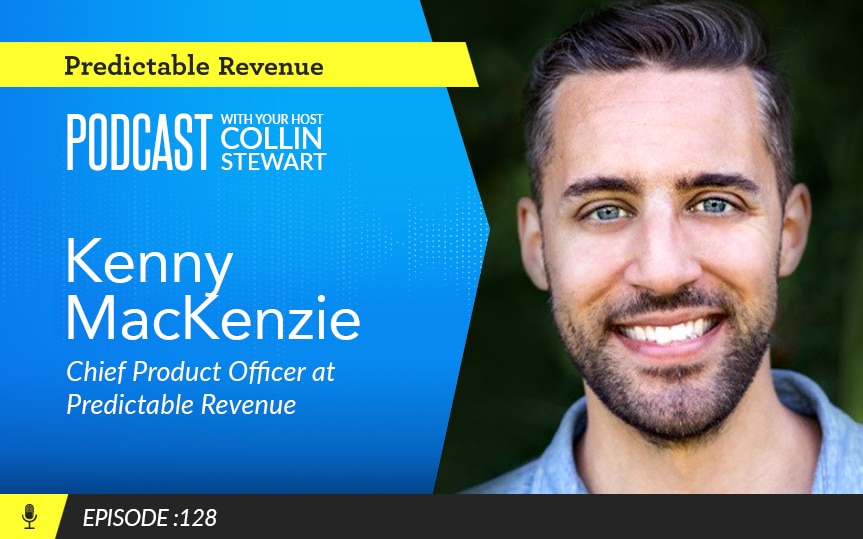How Predictable Revenue Built its Innovative Outbound Validation Program

Finding product market fit is hard. Really hard.
Years ago, me and my business partner at the time set out to build a CRM, Carburetor we called it. We did a lot of things right at that company – particularly on the sales and marketing side. Our issue, unfortunately, came down to product.
We were building something the market wanted, but we didn’t execute.
Kenny MacKenzie, Predictable Revenue’s Chief Product Officer, has a similar story. A few years back, he had bootstrapped his company, Vandrico, to six figure revenue and a team of 13 people.
But they failed on the sales and marketing side – they developed a really cool, cutting edge piece of software that wasn’t aligned with what the market needed.
And that’s the story of entrepreneurship: even the best ideas can fail for a lot of different reasons.
Failure, though, can also inspire learning, passion, and your next idea. That’s what happened with Kenny.
His mistakes helped him realize that others struggle with product market fit as well. So, he set out to learn everything he could about bringing a product to market – he interviewed numerous founders, read every book he could get his hands on – so he could, in turn, help others.
And that’s what, ultimately, brought him to Predictable Revenue: to continue furthering that learning, help expand our market, and conceive of new creative offerings for our customers.

A changing landscape
It’s fair to say that a thing or two has changed since Aaron first wrote and published Predictable Revenue.
In those days, the Cold Calling 2.0 method had never been done before. And, well, the process worked pretty well – Predictable Revenue kicked off a tidal wave of prospecting, rooted in targeted emails and phone calls.
But, like all effective sales tactics, company after company took up the mantle and customers eventually got used to email prospecting. Conversion rates for email dropped from around 7% in those days to about .7% today.
Bottom line: email used to be unique, and it used to be much easier to get people on a call to book a meeting. The bar for engagement is just so much higher.
This shift in customer expectations, general sales knowledge, and channel effectiveness was the climate Kenny found himself in when he joined us. And, just as all sales teams were collectively dealt with the evolving sales landscape, so were we.
Case in point: some of our clients were taking too long to see results and we needed to try something new. We needed a new way of understanding what our client’s markets respond to, and who to target.
We needed Outbound Validation.
“There was a realization, based on internal discussion, and we realized we needed a better way of getting our customers to results faster,” says Kenny.
“We needed to get back to basics.”
(Editor’s note: we had Bowery Capital’s Andrew Oddo on the podcast a while back to discuss how to evolve your sales playbook. You can learn more about our chat here)

Outbound validation…and the four pillars of sales
So, what is Outbound Validation?
It’s our new program, in which we focus on testing the different targets and messages that may or may not resonate with a customer’s market (this could be an existing market, or a potential new market).
Sales, generally speaking, is based on four pillars:
- Targeting – how you isolate your market.
- Messaging – how you start the conversation to get them engaged.
- Channel – where you are starting that conversation.
- Tactics – automation tools, your CRM, how you structure your team, comp plans etc.
“It was the first two that was taking us too long to nail down,” says Kenny.
“And they form the basis for Outbound Labs. It started with a deep passion for figuring out who are the clients that will be easiest to close, and drilling into that. And, from there, it boils down to: figuring out who the people are that have to get the same job done. Not just job titles, but the people who have to execute a specific task.”
How it works
The Predictable Revenue team works with customers to determine and unpack why customers need their product. From there, the team breaks those theories into different hypotheses that can be tested in robust email campaigns (although email conversion rates are dropping, it is an inexpensive and easy-to-use medium, which is perfect for experimentation.)
Of course, anyone that responds positively – we classify all responses we get as either positive, negative, or neutral – is put i n touch with customers for a follow up sales call.
For each client we run up to 20 experiments a month, which usually involve a combination of 3-7 different targets and 3-7 different messaging options. Typically, we run a second group of experiments in the second month (for a total of 40 experiments).
It’s important to note: only a few of the hypotheses we test will perform better than the rest. For example, if we do 20 experiments, 15 of them will bring us nothing. And, maybe, 2 -3 experiments will yield get very little, while 2-3 will give us the positive results we’re looking for.
“We’re engaging people in real sales conversations – sometimes those are positive, sometimes they are neutral, and sometimes they are negative,” says Kenny.
“But that elicits all of this learning. So, even if there is a flop, we have a lot of learning to apply to the next round. You just need to make sure you are classifying all of the responses that you are getting.”
(Editor’s note: for a detailed breakdown of Outbound Validation, check out this piece Kenny wrote on our groundbreaking new program.)
Jobs to be done
Finally, the concept of “jobs to be done” is key to the Outbound Validation process. Basically, the “jobs to be done” framework is a way of looking at how to target people by the responsibilities (the jobs they do on a day-to-day basis) required of them at their job.
You might be thinking: isn’t this what I do by choosing to target certain job titles? Well, sort of. But, by understanding exactly what a target does, you can connect that knowledge directly to your product. A job title is merely a proxy for that more nuanced, and exact, understanding.
The jobs to be done framework can be subdivided into three levels:
- The goal: this is an overarching departmental or company-wide goals (for example, maybe it’s to increase revenue from outbound).
- Jobs to be done: building a targeted list, and to craft messaging.
- An obstacle: you’re not quite sure how to zero in on the right accounts, or you don’t really know what to say in your messaging.
By understanding those levels, you can fold each of them into your messaging to connect with your prospect. And that is exactly what we do with that understanding in outbound Validation, on behalf of our customers.
“We look for the relationship between the job to be done, why they care, and how they are currently thinking of getting that job done. Whenever you are faced with a goal or job to be done, they face obstacles in getting that job done,” says Kenny.
“It’s not a matter of manufacturing new want, it’s a matter of connecting yourself to what they already want. That is very hard to do – you can do it scientifically and systematically, if you have the time and the know how. But if you are taking guesses and stabs in the dark, you will miss that market and leave money on the table.”
For more on Kenny’s thoughts on Outbound Validation, check out the rest of his interview on The Predictable Revenue Podcast.
NO TIME TO READ?
Listen On:
